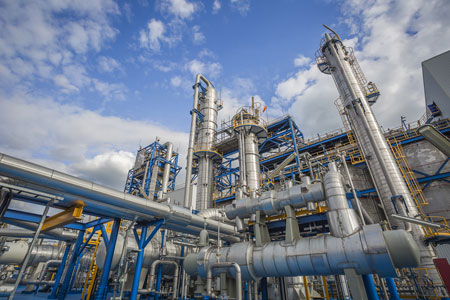
Hydrogen Sulfide Control with Hydrogen Peroxide
Hydrogen Sulfide Control with Hydrogen Peroxide
Sulfur compounds, such as hydrogen sulfide, thiosulfates and mercaptans, can present serious wastewater problems for refiners. Hydrogen peroxide treatment is a cost effective way to reduce sulfur species.
Download our Refinery Sulfide Oxidation Brochure (pdf)
Hydrogen Sulfide
Hydrogen sulfide is a problem in the refining processes and waste systems due to its offensive odor, toxicity and potential corrosivity. Even concentrations as low as 4 parts per billion (ppb), the odor can be detected and may be offensive in the plant area and the surrounding communities. In addition, hydrogen sulfide is considered toxic. Extended exposure to a few hundred ppm can cause unconsciousness and death.

Hydrogen sulfide also supports the growth of certain filamentous organisms such as thiothrix and beggiatoa, which are associated with bulking problems in activated sludge treatment. This condition can cause system upsets.
Hydrogen sulfide is a byproduct of many refining processes. Even when not produced directly during refining processing, hydrogen sulfide is a frequent wastewater contaminant because of the conversion of sulfates to hydrogen sulfide by bacteria under anaerobic conditions. This is a particular problem during summer months and/or during periods of high BOD/COD loading, when the oxygen demands of a system are exceeded, resulting in septic conditions.
Hydrogen peroxide reacts with hydrogen sulfide under acid, neutral and alkaline conditions. The reaction is accelerated by increasing temperature and/or the addition of catalysts such as iron. The stoichiometry is also affected by pH.
Under acidic or neutral conditions the reaction with hydrogen peroxide produces sulfur and water:
H2S + H2O2 → S + 2 H2O
Ideally, hydrogen peroxide at acidic/neutral pH reacts pound for pound with hydrogen sulfide; however, since waste streams often contain other reactive materials, it may be necessary to add more than the stoichiometric amount of hydrogen peroxide.
In alkaline solution (> pH8), the dominant reaction is:
Na2S + 4 H2O2 → Na2SO4 + 4 H2O
The 4/1 wt. ratio of H2O2/Sulfide can be lowered by using a combination of air and hydrogen peroxide.
Sulfites
Sulfur dioxide and/or its aqueous by-product sulfite can be generated in several refinery processes. Sulfite can cause high oxygen demand in waste water leading to anaerobic conditions and creating odor problems.
Hydrogen peroxide oxidizes sulfur dioxide/sulfite to sulfate. The reaction occurs over a wide pH range but is faster at lower pH.
Thiosulfates
Thiosulfate wastes can be generated as products of petroleum refining.
The product of the reaction between hydrogen peroxide and thiosulfate is dependent on pH and catalysts.
In alkaline solution (pH >8), hydrogen peroxide oxidizes thiosulfate to sulfate without a catalyst. At ambient temperature or under mildly elevated temperatures, the reaction takes several minutes for completion. The addition of a metal catalyst will accelerate the reaction.
Between pH 4-8, in the absence of catalysts, thiosulfate is oxidized to tetrathionate.
Between pH 4-8, hydrogen peroxide catalyzed by certain metals will convert thiosulfate to sulfate.
It takes 1.21 parts by weight of hydrogen peroxide to oxidize 1.00 part by weight of thiosulfate to sulfate.
Mercaptans (RSH)
These sulfur compounds, are present in a number of refinery wastes, emit highly objectionable odors and are considered toxic.
Mercaptans undergo oxidation under acidic conditions according to the equation:
2 RSH + H2O2 → RSSH + 2 H2O
The reaction occurs over several minutes and often produces water insoluble disulfides which form an oily layer that is readily separated.
Dialkyl Sulfides (RSR)
Dialkyl Sulfides are oxidized with hydrogen peroxide according to the equation:
2 RSH + H2O2 → RSSH + 2 H2O
Phenols
Among sources of phenolic waste discharges are petroleum refineries. Phenols are considered toxic to marine life.
Biological systems used to destroy phenols in wastewater are subject to malfunction if care is not exercised in design and operation to avoid problems such as “shock loading.” Also in cold weather, low temperatures can affect the digestion of phenols. During these times, hydrogen peroxide can be added to biological systems to improve performance.
Hydrogen peroxide destroys phenols rapidly at ambient temperatures when the reaction is catalyzed with a soluble iron salt (e.g. ferrous sulfate, Fenton’s Reagent) over a pH range of 3 – 6. The oxidation progresses through ring splitting to dibasic acids, leading ultimately to carbon dioxide and water.
As opposed to total oxidation, often, only enough hydrogen peroxide is used to remove the phenol group. Usually a 3/1 weight ratio of hydrogen peroxide to phenol is sufficient to achieve this goal. Many substituted phenols also respond to Fenton’s Reagent treatment.
USP Technologies
5640 Cox Rd.
Glen Allen, VA 23060
Toll-free (800) 851-8527
Phone (804) 404-7696
USP - Canada
3020 Gore Road
London, Ontario N5V 4T7
Toll-free (800) 851-8527
Phone (804) 404-7696